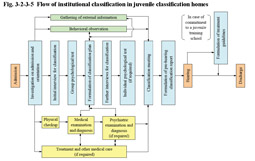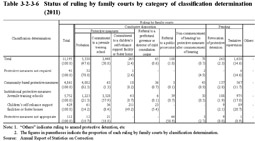2 Classification activities
(1) Institutional classification
Fig. 3-2-3-5 shows the standard fl ow of classification for juveniles referred to juvenile classification homes (institutional classification). Whether to subject them under a community-based protective measures (probation, etc.) or institutional protective measures (commitment to a juvenile training school, etc.) is determined (classification determination) based on the results of classification interviews, psychological tests, behavioral observations, and medical diagnosis, as well as other external information. The result of the classification determination is then recorded in a report along with the characteristics of the juvenile’s predisposition, factors that may have led them into delinquency, and guidelines for their reformation/rehabilitation, and is submitted to the family court as data for the hearing. After the ruling to subject them under protective measures, the result of the classification determination is sent to the juvenile training school or probation office for use as reference material in the juvenile’s subsequent treatment.
Fig. 3-2-3-5 Flow of institutional classification in juvenile classification homes
Table 3-2-3-6 shows the relationship between the classification determination and ruling by family courts, etc. of juveniles whose classification determination was completed (only those placed under protective detention and discharged in 2011).
Table 3-2-3-6 Status of ruling by family courts by category of classification determination (2011)
(2) Non-institutional classification
a. Classification at the request of a family court without physical restraint
Although institutional classification takes place in most cases that are dealt with by family courts, classification can also take place by summoning a juvenile to a family court or a juvenile classification home, etc. without physical restraint. In 2011, 228 juveniles received classification without physical restraint (Source: Annual Report of Statistics on Correction).
b. Classification at the request of the relevant agencies in Ministry of Justice
The number of persons received for classification at the request of a relevant agencies in Ministry of Justice in 2011 was seven from public prosecutors offices, 4,356 from juvenile training schools or penal institutions, and 5,929 from Regional Parole Boards or probation offices (Source: Annual Report of Statistics on Correction).
Classification activities that take place in the classification upon request include classification of the subjects’ predisposition, individual or group psychological tests, and interviews and enquiries, etc. for formulating or changing their treatment plans.
c. Classification services for the general public, etc.
Classification services can also take place upon request from the general public or public/private organizations, etc. The content is rather wide-ranging and includes not only delinquency but also juveniles’ character, discipline, and any necessary student guidance, etc. In addition, efforts are being made to actively provide local communities with specialized knowledge/skills on psychology, etc. by participating in the network of relevant institutions engaged in supporting the development of children/young people in the local communities in accordance with the “Act on Promotion of Development and Support for Children and Young People” (Act No. 71 of 2009).

